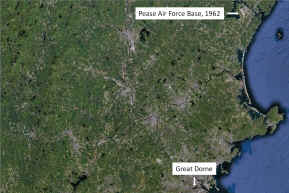Road trip
-
-
slice.mit.edu
- 1
Filed Under
Recommended
 Professor Patrick Henry Winston ’65, SM ’67, PhD ’70
Professor Patrick Henry Winston ’65, SM ’67, PhD ’70It was scary, that Cuban Missile Crisis, 50 years ago. I was a sophomore at the time, and we all talked about getting vaporized, believing Boston would be a prime target. A fellow sophomore suggested we get out of town, and after thinking about the odds a while, I agreed. Several of us packed into his Volkswagen and headed north.
Hours later, we felt we were safe from the potential nuclear holocaust. We had made it all the way to New Hampshire, after all. Then, a big sign appeared in front of us:
Pease Air Force Base Strategic Air Command
Feeling pretty stupid, we decided to go home, but on reflection, Pease Air Force Base might have been as safe as any place in the country. The Soviets would have expected that all the B52s were in the air by then.

Comments
Bruce Bottomley '65
Tue, 10/30/2012 3:21pm
A story from that same era (quite paraphrased) has a guy living in New York City around the beginning of World War II. The New York Times published a map of the radius of destruction that would result if the Germans dropped their biggest bomb on the Empire State building. He moves uptown for his own safety. Then comes the A-Bomb, a new map, a much wider circle, and he moves to Westchester. The first H-Bomb, another new map, and he's in Connecticut. Finally the 1961 50 Megaton bomb (designed as 100 but they were too scared to try it at that yield), one more map in the Times, and he's well into Massachusetts.
A neighbor comes up to greet him as the moving van is bring unloaded. The New York guy pulls out his copy of the Times and proudly shows it to the neighbor. "I'm safe here" he says. To which the neighbor replies, "Did you see today's Boston Globe?"